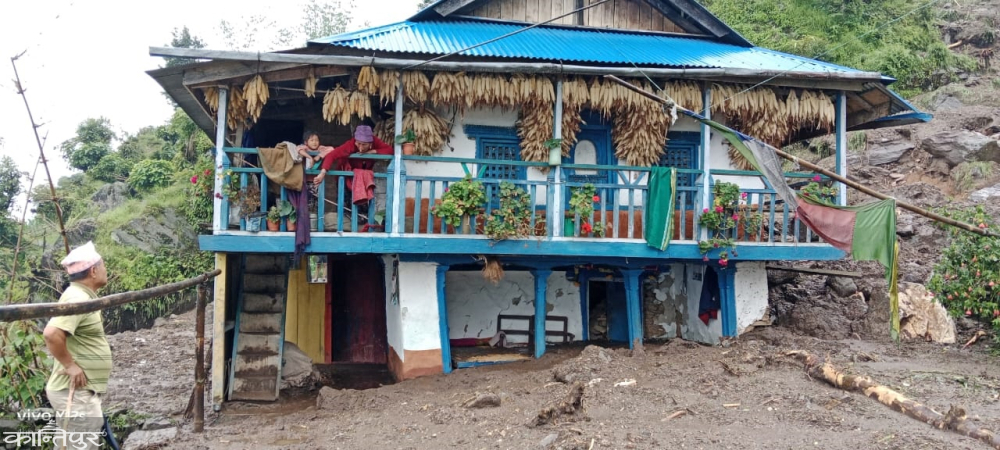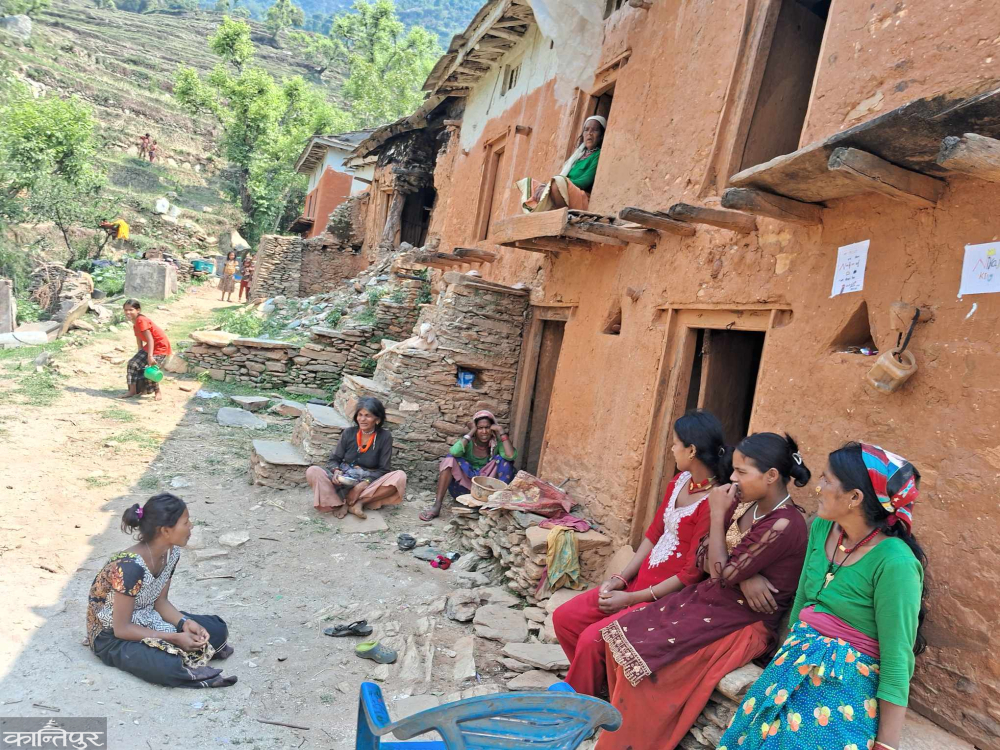The dread of the annual calamity

We use Google Cloud Translation Services. Google requires we provide the following disclaimer relating to use of this service:
This service may contain translations powered by Google. Google disclaims all warranties related to the translations, expressed or implied, including any warranties of accuracy, reliability, and any implied warranties of merchantability, fitness for a particular purpose, and noninfringement.

Highlights
- Government preparedness to prevent damage is thin, delaying relocation of those living in vulnerable landscapes



As June approaches, the incidence of natural disasters has started to increase. Natural calamities cause a large number of amputations and loss of life every year. The government's lackluster efforts to contain disaster damage and delays in relocating those living in vulnerable terrain have forced thousands of locals to live with memories of their tragic past and fear of a possible future.

Kantipur tried to understand the havoc of disaster-stricken locals in Taplejung, Doti, Bajhang, Sankhuwasabha and Panchthar and their risky stay. It is clear that the government's efforts to prevent the damage caused by natural disasters are still not enough.
Before dawn on Friday, the house of Ravin Samra Limbu, Vice President of Paktanglung Rural Municipality, was struck by grief. Ravin's 71-year-old father Ram Bahadur, 48-year-old mother Jammaya and 10-year-old twin sisters Ganga and Jamuna died in the midnight landslide. Bhupendra Chaulagain, the ward president of Paktanglung Rural Municipality-2, said that there was heavy rain overnight in his village in the northwest, which is five hours away from the headquarters. Choulagain, who is also the spokesperson of the rural municipality, said, "There has been heavy rain since the evening causing landslides."
 40-year-old Yugen Samra and his three-year-old daughter were injured in the landslide in Khezenim Mavicheu of this ward. The injured are being treated at the district hospital. According to the data of the District Police Office, except for 2078, there has been no year without human casualties due to floods and landslides in the district. According to the data of the District Disaster Management Committee, there is a risk of landslides in all but two of the 61 wards of the district. Chief District Officer Ravindra Acharya said that all wards except Fungling Municipality-2 and 5 are at risk of landslides. According to him, 4 wards are at high risk and 18 are at medium risk. The ward that was hit by a landslide on Friday is also at high risk of disaster.
40-year-old Yugen Samra and his three-year-old daughter were injured in the landslide in Khezenim Mavicheu of this ward. The injured are being treated at the district hospital. According to the data of the District Police Office, except for 2078, there has been no year without human casualties due to floods and landslides in the district. According to the data of the District Disaster Management Committee, there is a risk of landslides in all but two of the 61 wards of the district. Chief District Officer Ravindra Acharya said that all wards except Fungling Municipality-2 and 5 are at risk of landslides. According to him, 4 wards are at high risk and 18 are at medium risk. The ward that was hit by a landslide on Friday is also at high risk of disaster.
On Thursday, three bridges were swept away by the flood in Sisne River, which flows through Siseva of Tapethok in Paktanglung-5 and Linkhim in Ward 3 and Furumbu in Fungling-10. Due to damage to two river bridges and roads, traffic operations have been disrupted since Thursday. According to Deputy Superintendent of Police Ravi Rawal, the rains from Wednesday to Friday have caused damage in Mikwakhola, Paktanglung and Sirijanga Rural Municipality.
After the start of June, 50-year-old Jasu Vick from Sayal Rural Municipality-5 Gurina in Doti can hardly sleep. He is worried about how often the landslide will sweep away the house and he will not be able to tell until he asks. In 2078, Hiruwa Vick's husband, who was staying inside the house, died due to the landslide. At that time, all his wealth including 2 houses with 4 rooms were taken away by the landslide. Although Balbal survived, Jasu could not leave this place. "The house is still in danger, I don't know when the river and landslide will take it away," she said, "As many as those with arms and legs have fled to other places, I am waiting for tomorrow."
Everyone is in a distant state, even in neighboring Khanjari Vic. His eldest son Bhim Vick was seriously injured in the 2078 landslide. "After the son of the breadwinner fell in the landslide, we have not even been able to sleep because the same thing will happen again," Khanjari said. Out of which Dalit settlements are at high risk of landslides. Because of the settlements on the steep hills, the land is moving towards the river every year. Even though a general embankment has been made in the lower part of the village with the help of the municipality, the village is not safe. Local women leader Durga Sharma said that the village should be moved to a safe place.
Sayal rural municipality chairman Dharam Joshi said that even though he requested the federal and state governments several times to relocate the vulnerable families, they were not heard. He said that 32 in Bhudkela village, 37 in Babansain, 12 in Gurina, 10 in Ghangare village and 10 in Bhunk are at high risk. Chief District Officer Govinda Prasad Aryal said that actual data collection of high-risk families is underway. 'In a few days, the data of the entire district will come,' said Aryal, 'I have not received reports from the municipalities that the settlement has to be relocated.' His family of 18 were sound asleep in the rain. Kalak was unaware of the rumbling and thundering of the Dikligad river that flowed through the village. Neighbor Nare Sarki's family came and called him repeatedly, so he got up in a hurry. Water was flowing outside the house. Nare was afraid that he would not survive if a landslide happened last year on Dhogdina hill above his house. So he came to Kalak's house. Nare kept the family inside the house and walked to the house above Kalak to see if they could bring some grain. After carrying a bag of rice and some clothes, they were about to leave when a landslide came down with a heart-pounding sound. They jumped to a safe place saving their lives.
 After half an hour, the landslide stopped. Looking back, Nare's house survived the landslide, but 6 houses were swept away by the landslide, including Kalakko's. 23 people died including 18 from Kalak's family and 5 from Nare's family. Describing that moment, Kalak said, "Looking at it, everything of both the families was gone." Even now, I remember that moment and I shudder. Nare, who has lost all his family members, has been living as a watchman in India since that incident. Kalak has built another house in the village. Dikla village has been damaged by landslides and road construction, Kalak said if there is heavy rain again, the village will be washed away. 12 families of this village have left the village due to the fear of landslide. Where should we go?' he said.
After half an hour, the landslide stopped. Looking back, Nare's house survived the landslide, but 6 houses were swept away by the landslide, including Kalakko's. 23 people died including 18 from Kalak's family and 5 from Nare's family. Describing that moment, Kalak said, "Looking at it, everything of both the families was gone." Even now, I remember that moment and I shudder. Nare, who has lost all his family members, has been living as a watchman in India since that incident. Kalak has built another house in the village. Dikla village has been damaged by landslides and road construction, Kalak said if there is heavy rain again, the village will be washed away. 12 families of this village have left the village due to the fear of landslide. Where should we go?' he said.
Madan Saud, a teacher of the local Shanti Secondary School in Parakatne, said that all areas from Dikla to Kapra village in Thalara-4 are at high risk of landslides, so 82 families are living in danger every Barkha. Even in the Disaster Preparedness and Response Plan 2080 prepared by the District Disaster Management Committee Bajhang, it is mentioned that 5 villages of Thalara are at risk of landslides. But Prakash Rokaya, chairman of the municipality, said that they could not do anything. "It is not possible to prevent the damage with the resources and manpower of the municipality," he said.
In the preparedness and response plan, it is mentioned that 47 villages in 12 municipalities of the district are at high risk of landslides. In 2018, GeoHazard International, an international organization that studies natural disasters, published a report on the high risk of Bajhang landslide. It is mentioned that there is a risk of landslides in 6,630 places in 12 municipalities of the district. Chief District Officer Vishwamitra Kuinkel said that some settlements have to be relocated.
On June 27, 2077, 11 people were killed in a landslide that occurred in Basinda and Chepcheva of Silichong-1 Sisuvakhola. After more than one hundred and four houses were damaged, the District Disaster Management Committee decided to shift the locals to Chitre, Bakhaltum and Khandbari-7 of Silichong-1. But even after 4 years of displacement, their house has not been built yet. In the coordination of Khandbari Municipality, land was managed for 13 million for 55 families in Bhairedanda of Ward No. 7. Mayor Mahesh Thapalia said that houses are also being built for the displaced. Houses are being built for the displaced families of 12 in Chitre Danda of Silichong-1 and 37 in Bakhaltum.
Laxmimaya Thapa of Fidim Municipality-4 of Panchthar has not rested for a month. When it rains, his mind remembers the suffering caused by the flood in Hewa on June 2 last year. Remembering that day, she said, 'The sun was hot till noon. No one expected that there would be heavy rain all at once. In the middle of the night, torrential rain started pouring down. The flood came in an instant. The flood washed away the ripened corn and paddy in Laxmimaya's field. She said, 'Relief and compensation was not received from anywhere until a year after the flood. It's June again. What will happen this time.'
After last year's floods destroyed his farm, Resham is camping in Thapatar near Katuwal. Remembering that the flood swept away the Hewa river bridge of the Mechi highway connecting Phidim and Bharpa, Resham said that he had not received any relief or compensation from the government. Yangwarak of Panchthar, Hewa with Phalelung Rural Municipality and most of the places in Panchthar including Phidim and Hilihang touched by Tamor river Gadtir are at risk of flood and landslide. The big floods that happen here every year have been causing damage to people's wealth.
6 people from Panchthar lost their lives in last year's flood, while 608 people from 314 houses in the district were displaced. Last year, floods washed away 8 concrete and 9 suspension bridges. Among the rivers, the federal government has constructed a belay bridge only on the Hewa River on the Fidim Taplejung road section of the Mechi highway. Birvikram Thamsuhang, president of Phalelung, said, "We have a limited budget, we have been urging the federal and state governments many times to build a bridge, but there was no hearing."
 प्रकाशित : असार ४, २०८१ ०६:५७
प्रकाशित : असार ४, २०८१ ०६:५७

 २२.१२°C काठमाडौं
२२.१२°C काठमाडौं











